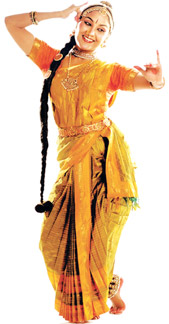Place of dance in Tamil cultural history
Subashini PATHMANATHAN
What we know Bharatha Natyam today evolved out of temple dances which
have a history which goes back to many centuries. The ancient Tamil
kings fostered and developed the arts and promoted religion. The
numerous inscriptions found all over Tamil Nadu bear testimony to the
seal of the kings who endowed lands to the temples.
Out of these income certain amount were instructed and directed to
give for the maintenance of the welfare of the temple priests and temple
dancers, and the mentors of dancers as Nattuvanars. Even it is
noteworthy to mention here that some of the temple inscriptions clearly
indicate that certain amounts of payment was allocated to buy betel and
areca nuts for temple Nattuvanar and temple musicians.
 |
|
Bharatha
Natyam was established as a great classical dance of India |
According to historical evidence, the Sangam period Silapathikaram
contains the wealth of information about dance. During the Chola regime
the great temple Thanchai Bragatheswarar was built by great Chola
emperor Raja Rajacholan.
To this date, this temple remains as a monument to dance and
sculpture of Chola era. One of the temple inscriptions states that four
hundred dancers were appointed to serve the deity at this temple. As
Tamil kingdom faded away the temple dances declined and eventually the
temple dances were moved to the palaces of the petty kings. With the
eclipse of Marathi rule Tamil dance lost it‘s total glamour and own
identity.
Downfall
After the Marathi rule the British era started. With the coming of
British rule, Sathir (the earlier form of Bharatha Natyam) which the
Britishers called Nauch began to decline. And the female dancers were
socially ostracized. In the year 1947 the performances of Sathir at
temples was legally prohibited. The renaissance of Bharatha Natyam began
after the first quarter of twentieth century with the aid of Krishna
Iyer, and Rukmani Devi Arundale and several others. All of these
cultural reformers played major role to revive this art. Sathir was
rechristened as Bharatha Natyam due to their untiring efforts of the
revivals. Women of upper classes took to this dance. The Madars Music
Academy permitted dancers to perform at the Academy. Perhaps the most
important influence that stimulated the interest in the art form was
Tamil cinema.
The Nattuvanars of the old tradition who took up residence in Madras
directed many dance scenes in Tamil cinema and talented young girls like
Kamala and Vyjanthimala were trained by some outstanding dance Gurus
like Vazhuvoor Ramiahpillai, and Thandauthapani pillai. The presentation
of dance scenes in the Tamil cinema impressed the imagination of South
Indian masses and established Bharatha Natyam as a great classical dance
of India.
Balasarswathi was conferred the title ‘ Sangeetha Kalanithi’ and this
marks the ultimate recognition of this great art. Dr.Raghavan by his
writings contributed a great deal to recognition of Bharatha Natyam as a
classical dance. The Nattuvanars who belonged to a particular caste were
called upon to teach the girls from the higher classes in the social
hierarchy who took Bharatha Natyam enthusiastically. Today in the
classical Bharatha Natyam scene Nattuvanars are a vanishing tribe,
because the dance teachers of today take upon themselves the task of
rendering Nattuvagam.
Classics
There are a few handful of traditional Gurus are in the classical
dance scene. For a student learning Bharatha Natyam under a traditional
Guru is entirely a different experience rather than learning under an
institution. Learning classical dance under traditional Gurus the sishya
naturally imbibes the art, whilst learning classical dance at the
institution one only learns the art itself.
Sathir appeared in the Sri Lanka scene especially in the Jaffna
peninsula where it was danced in Hindu temples for at least over three
hundred years. These dancers were generally referred as devadiyals,
which literary means those who rendered service to the Lord. Their
Indian counterparts were often referred to Devadais. In Jaffna they were
called sometimes as Sinnamela karis or Sathir Karis.The persons who
teach them were called Nattuvanars and both belonged to the same social
class.
This class tended to live in close proximity to the temples. Lands
occupied them are still known as Nattuvakani, it means that the land of
Nattuvanar clan.
|





